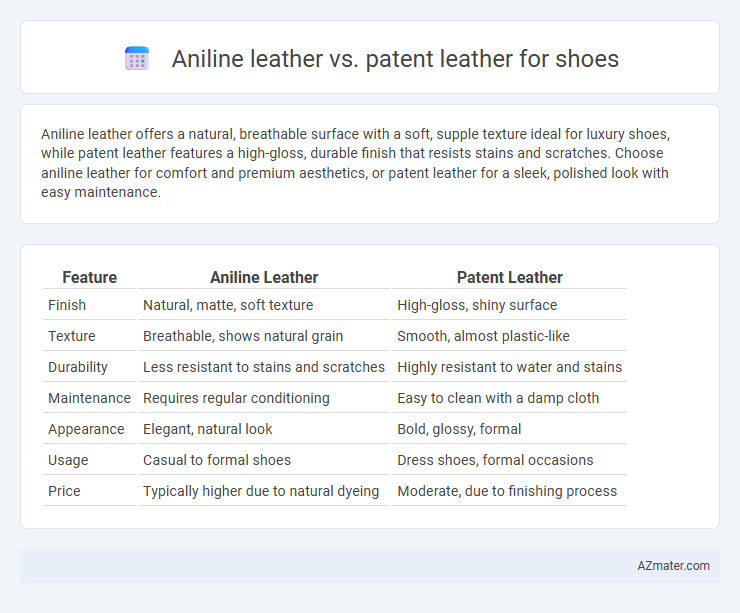Aniline leather offers a natural, breathable surface with a soft, supple texture ideal for luxury shoes, while patent leather features a high-gloss, durable finish that resists stains and scratches. Choose aniline leather for comfort and premium aesthetics, or patent leather for a sleek, polished look with easy maintenance.
Table of Comparison
| Feature | Aniline Leather | Patent Leather |
|---|---|---|
| Finish | Natural, matte, soft texture | High-gloss, shiny surface |
| Texture | Breathable, shows natural grain | Smooth, almost plastic-like |
| Durability | Less resistant to stains and scratches | Highly resistant to water and stains |
| Maintenance | Requires regular conditioning | Easy to clean with a damp cloth |
| Appearance | Elegant, natural look | Bold, glossy, formal |
| Usage | Casual to formal shoes | Dress shoes, formal occasions |
| Price | Typically higher due to natural dyeing | Moderate, due to finishing process |
Introduction to Aniline and Patent Leather
Aniline leather is a type of leather dyed exclusively with soluble dyes, preserving the natural surface, texture, and breathability, which makes it highly prized for its soft feel and unique character. Patent leather, on the other hand, features a glossy, high-shine finish achieved by applying a lacquer or synthetic coating, offering excellent water resistance and a sleek, polished appearance. When choosing between aniline and patent leather for shoes, consider that aniline emphasizes natural aesthetics and comfort, while patent leather prioritizes durability and eye-catching style.
Key Characteristics of Aniline Leather
Aniline leather is a high-quality, natural leather dyed exclusively with soluble dyes that preserve its original surface texture and natural markings, making each shoe unique. It offers exceptional breathability and softness, enhancing comfort and allowing the leather to age gracefully with a rich patina. Unlike patent leather, which has a glossy, synthetic coating for water resistance and durability, aniline leather prioritizes natural aesthetics and suppleness but requires more care to prevent stains and fading.
Defining Patent Leather: Features and Appeal
Patent leather is characterized by its high-gloss finish achieved through a coating process that enhances durability and gives a sleek, mirror-like appearance. This type of leather is popular for shoes due to its water resistance, easy cleaning, and polished aesthetic ideal for formal occasions. The smooth, reflective surface contrasts with the natural grain of aniline leather, offering a distinct appeal that combines elegance with practicality.
Appearance and Aesthetic Differences
Aniline leather exhibits a natural, matte finish that highlights the full grain and texture variations of the hide, offering a rich, authentic appearance ideal for a classic, understated look. Patent leather features a glossy, reflective surface achieved through a lacquer coating, creating a sleek, high-shine aesthetic that stands out for formal and fashion-forward footwear. The choice between aniline and patent leather hinges on the desired visual effect: subtle elegance versus bold shine.
Durability: Aniline vs. Patent Leather
Aniline leather offers moderate durability due to its natural finish and minimal protective coating, making it more prone to stains and scratches compared to patent leather. Patent leather, coated with a high-gloss polyurethane layer, provides superior resistance to water, stains, and scuffs, enhancing its longevity for everyday shoe use. For long-lasting footwear, patent leather outperforms aniline leather in durability while maintaining an eye-catching shine.
Comfort and Breathability in Shoes
Aniline leather offers superior breathability and comfort due to its natural, untreated surface that allows air circulation, making it ideal for prolonged wear in shoes. Patent leather, coated with a glossy, impermeable finish, restricts airflow and can cause feet to become hot and sweaty, reducing overall comfort. For footwear prioritizing breathability and softness, aniline leather provides a more luxurious and breathable experience compared to the less flexible, plastic-like patent leather.
Maintenance and Cleaning Requirements
Aniline leather requires gentle maintenance with mild soap and water, avoiding harsh chemicals to preserve its natural texture and color. Patent leather is easier to clean, often needing just a damp cloth to remove dirt and a specialized polish to maintain its glossy finish. Both types benefit from regular conditioning to prevent cracking and maintain flexibility over time.
Water Resistance and Weather Suitability
Aniline leather offers a natural, breathable surface but lacks water resistance, making it less suitable for wet or harsh weather conditions. Patent leather features a glossy, waterproof finish that provides excellent protection against water and is ideal for rainy or damp environments. Choosing patent leather ensures durability and easy maintenance in adverse weather, while aniline leather is better suited for dry, moderate climates.
Environmental Impact and Sustainability
Aniline leather, derived from natural hides with minimal surface treatment, tends to have a lower environmental footprint due to reduced chemical use in its processing compared to patent leather, which requires heavy coatings and synthetic finishes that contribute to pollution and non-biodegradability. The tanning and dyeing processes for patent leather often involve toxic solvents and plastics, making it less sustainable and harder to recycle, whereas aniline leather's organic composition supports better biodegradability and less waste generation. Choosing aniline leather for shoes aligns more closely with eco-friendly and sustainable practices by minimizing toxic chemical emissions and enhancing material biodegradability in the product lifecycle.
Choosing the Right Leather for Your Shoes
Aniline leather offers a natural, breathable texture with minimal finish, making it ideal for those seeking a soft, luxurious feel and a unique patina over time. Patent leather features a high-gloss, durable surface created by coating the leather with lacquer, providing a sleek, water-resistant option perfect for formal and high-shine shoe styles. Understanding the intended use and desired aesthetic helps determine whether the supple, matte appeal of aniline or the polished, protective finish of patent leather better suits your shoe needs.

Infographic: Aniline leather vs Patent leather for Shoe
 azmater.com
azmater.com